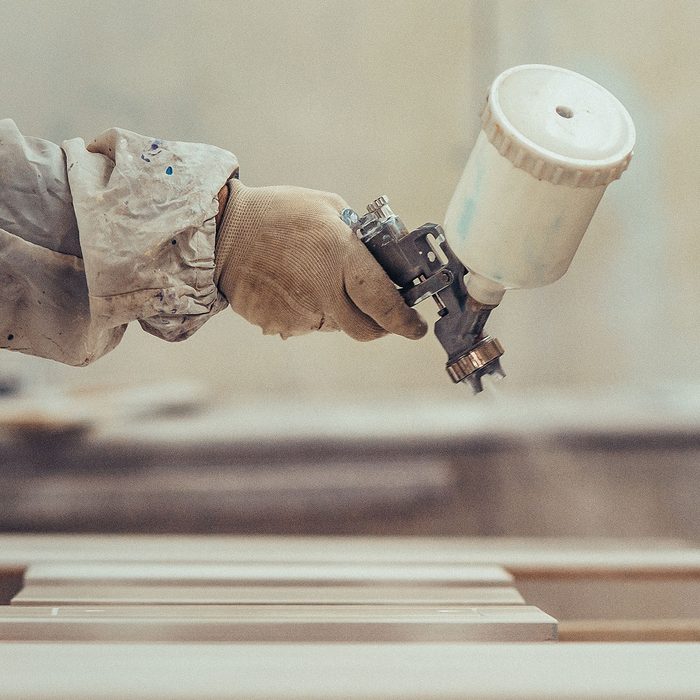
Using Your Spray Painter
As a core piece of equipment that a professional painter relies on, the importance of keeping a paint sprayer clean and well-maintained goes without saying.
According to painting pro, Nick Slavik of Nick Slavik Painting and Restoration in New Prague, Minnesota, a methodical cleaning procedure translates to reliable equipment, extended lifespan, and eliminating the cost of having the sprayer repacked (and the downtime that entails).
A sprayer left in an uninsulated Minnesota garage for several years was put back in service within minutes because it had been cleaned using Slavik’s 5- to 7-minute procedure. See Slavik’s paint sprayer cleaning procedure.
Plain and simple, strict maintenance of your paint sprayer saves you time and money. Practicing these tips will boost the profitability of your painting business.

Attach Laminated Procedure Cards to the Paint Sprayer
Let’s face it, good help can be hard to find and getting new employees up to speed takes time. Slavik protects his investment by printing cards that list his step-by-step procedure for cleaning out a paint sprayer. After laminating them, he attaches one to each device with a zip tie. Learn more about HVLP paint sprayers.

Recovering Coating Left in a Paint Sprayer Is Like Finding Money
When you shut off your paint sprayer at the end of the day as much as a quart of material may be left in the lines. Recognizing and recapturing this material can save you from having to buy an extra gallon for touch-ups, according to Slavik. Over the course of a year, that can lead to substantial savings for a professional painter. See our guide to exterior spray painting.

Water Required to Clean a Paint Sprayer
You can clean a paint sprayer with as little as 1 gallon of water. Clean water is becoming a precious resource, and slop water from cleaning out your paint sprayer is now considered hazardous material that must be collected and waste-streamed properly.
States such as Minnesota have instituted a tax based on gallons of paint sold, and sellers collecting the tax must also collect waste paint and slop contaminated with paint. Slavik recommends saving yourself some of the hassle by restricting the water used in clean-out to between 1 and 2 gallons.

Don’t Forget the Filters
After an initial flush out with water through both the prime and spray-gun lines, remove the filters, dip them in water, and agitate to clear them out. Material trapped in the filters takes more water to clear, resulting in more wastewater and extra cost and effort in the long run, says Slavik.

How Clean Is Clean?
Staying with the theme of limiting waste to benefit the environment and your bottom line, Slavik says that 96% clean is clean enough. Any more than that just wastes solvent (water or paint thinner) and creates more work to dispose of the slop. An initial flush, followed by clearing the filters and a final flush, cleans your paint sprayer to the point where even vivid colors will not taint your next job.

Store Paint Sprayer Tips Wet
Cleaning out a tip clogged with dried coating takes time and creates wear on the tip. Slavik stores his paint sprayer tips in a jar of thinner fitted with a basket to lift them out, although he admits that a Mason jar does the job just fine. When it is time to paint, the tips are always ready to go.

A Minimal Investment That Pays Dividends
The procedure of cleaning and maintaining a paint sprayer offers a professional painter the opportunity to extend the life of his equipment, reclaim usable material, reduce waste, and minimize down time—all of which add up to cost savings and increased profitability. Once you become familiar with it, the entire process takes little time and keeps you moving smoothly from job to job. With the proper care your paint sprayer can last 20 years or more.
About the Author and Expert:
Nick Slavik is the owner of Nick Slavik Painting and Restoration Co. in New Prague, Minnesota. He has more than 25 years experience as a professional painter, has served his country through two tours of duty in the Middle East, is a contributor to “This Old House,” and produces a weekly Facebook show called “Ask A Painter.” www.nickslavik.com.
Craig Gustafson is a writer and editor based on the East Side of St. Paul, Minnesota. He spent several formative years working on a construction crew and enjoys home-improvement projects of many types. His family has recently purchased a small property in Northern Wisconsin with a shell standing on it, which they look forward to finishing themselves.
